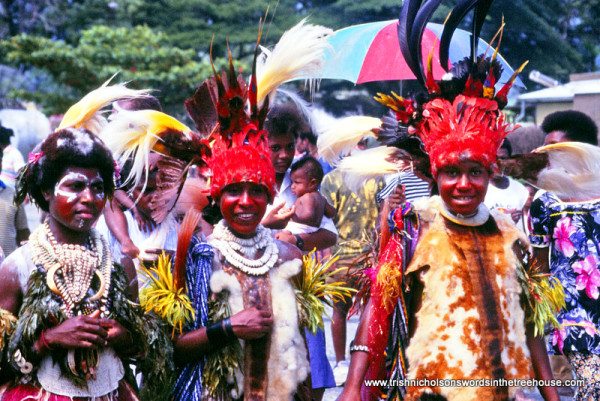
We all want to be ‘travellers’ rather than ‘tourists’. One way to achieve this is to show the cultural courtesy of learning a few phrases of the local language. And to join in the laughter with good grace when we get it wrong to the great amusement of our listeners – they will still appreciate the effort.
But it will take a special effort in Papua New Guinea, the most culturally diverse nation on earth, which has 800+ languages.
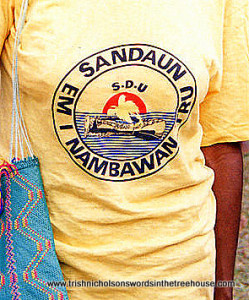 Melanesians are adept linguists, often speaking several local languages, and in towns and cities English as well, but they are also pragmatists. Two main lingua franca have developed in Papua New Guinea to enable communication across so much diversity: Hiri Motu in the south of the country, and Tok Pisin (Pidgin) almost everywhere except in remote villages where they may speak only their Tok Ples – the language of that particular place, one of the 800.
Melanesians are adept linguists, often speaking several local languages, and in towns and cities English as well, but they are also pragmatists. Two main lingua franca have developed in Papua New Guinea to enable communication across so much diversity: Hiri Motu in the south of the country, and Tok Pisin (Pidgin) almost everywhere except in remote villages where they may speak only their Tok Ples – the language of that particular place, one of the 800.
Tok Pisin is an economical language: nouns often double as verbs, words may have several meanings, and tenses are worked out by the listener according to context. There is, however, a clear logic in this expansion of meaning.
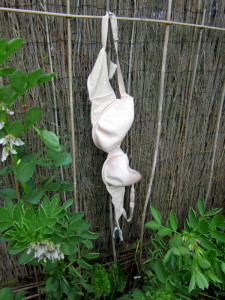 For example, ‘banis’ means a fence, boundary, wall, or dam, but the same word applies to a bandage around an injury, and your rib cage; it can also mean a woman’s brassiere.
For example, ‘banis’ means a fence, boundary, wall, or dam, but the same word applies to a bandage around an injury, and your rib cage; it can also mean a woman’s brassiere.
Combinations of words allow graphic expression. ‘Tok’ means a message, a word, speech, or to tell, and is applied in dozens of ways:
tok baksait – gossip, implying exaggeration or plain invention
tok amamas – to give good wishes (‘amamas’, or ‘hamamas’ means ‘happy’)
tok gris (pronounced ‘grease’) – to flatter, seduce, or to offer a bribe
tok krankie – talk foolishly or inaccurately (as in foreigners’ attempts at Tok Pisin)
tok save (pronounced ‘savvy’) – information, a message, or an official notice as in the one below, seen in a rural district office, banning the use of the office telephone for personal calls, and pointing out that this applies to politisen (politicians) as well, so don’t ask!
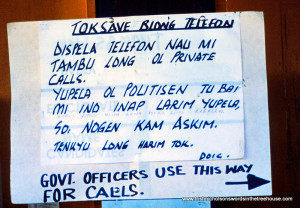 So what about bilas and asgras?
So what about bilas and asgras?
Bilas is ‘bling’, personal adornment, to dress up either in traditional or in modern gear, but also to mock: ‘ol i tok bilas long em’ – ‘everyone mocked him’.
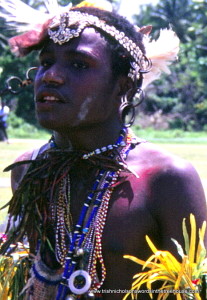 And asgras (pronounced ‘arsegrass’) describes bunches of leaves or grasses worn by men to cover the buttocks, especially in the Highlands.
And asgras (pronounced ‘arsegrass’) describes bunches of leaves or grasses worn by men to cover the buttocks, especially in the Highlands.
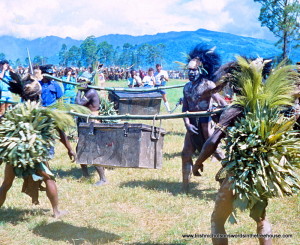 In this instance – a dramatic re-enactment of colonial times in Simbu – the extent of asgras amounts to bilas!
In this instance – a dramatic re-enactment of colonial times in Simbu – the extent of asgras amounts to bilas!
For more on the fascinations of Papua New Guinea and Tok Pisin, read Inside the Crocodile: The Papua New Guinea Journals – you will find there a glossary of Tok Pisin words and phrases as well as unique photographs. And don’t miss the book-trailer video here.
If you’d like to see a reader’s review, there is one here from the UK by author Anne Stormont, on Twitter as @writeanne, on her blog Put it in Writing. ‘There’s a real TV documentary feel to this book – so clear and vivid is the writing.’
A review in The Australian by old PNG hands, Keith Jackson and Phil Fitzpatrick is here.
In a review from in the Sydney Morning Herald , author and academic Gordon Peake @GordonPeake wrote: “With easy humour and affectionate prose, Nicholson has packaged together a lovely 40th birthday present for her once island home.”
And from Mexico, whose national holiday is 16 September the same as Papua New Guinea’s ‘birthday’, by journalist Nora Vasconcelos @noravsnews on her Traveling Book Blog, ‘..a remarkably moving story … a refreshing source of inspiration.’
Tenk yu tru!

Great stuff Trish, lovely big bra, very clean I thought. Love the colours of the photos. Happy independence day.
George.
Haha! Thanks George, had to make a trip to the local charity shop to find the ‘DDD’ cup which now sits in the ‘props’ cupboard.
Lovely, Trish. It’s amazing how close the language has stayed close to the, I presume, English basis, tok being talk etc. It reminds me of David Crystal’s future of Englishes talk that I went to. Fascinating. Happy PNG independence day!
Thanks, Val, hope it brought you a chuckle. Yes, a lot of ‘English/Australian’, I’m not a linguist, but there are probably some Dutch and German influences, too, and of course local and island words as well. It is very effective anyway.
I loved ‘asgras’. A wonderfully faithful description. When I was reading your dialogue in Inside the Crocodile, I often read it aloud. That way I could follow it quite well!
That’s a very interesting observation, Val, like all languages, I suppose, Tok Pisin was verbal before it was written, and it does seem to have kept that expressiveness and immediacy. Some phrases are still household words for me, like Maski! (forget it!) and of course, ‘baragap’.
What a fascinating language! I knew that Papua New Guinea had 800+ languages, but was not aware that the pidgin language had such recognisable roots in multiple Germanic languages. This has sent my linguist feelers all a-twitter!
Hi Jo, glad you enjoyed it. Yes, it is a fascinating language, and if you are intrigued further, Oxford University Press brought out a Tok Pisin -English Dictionary in 2008. Some of the definitions are different to mine because I have used what I heard in Sandaun, and there is much variation anyway. A truly living language!